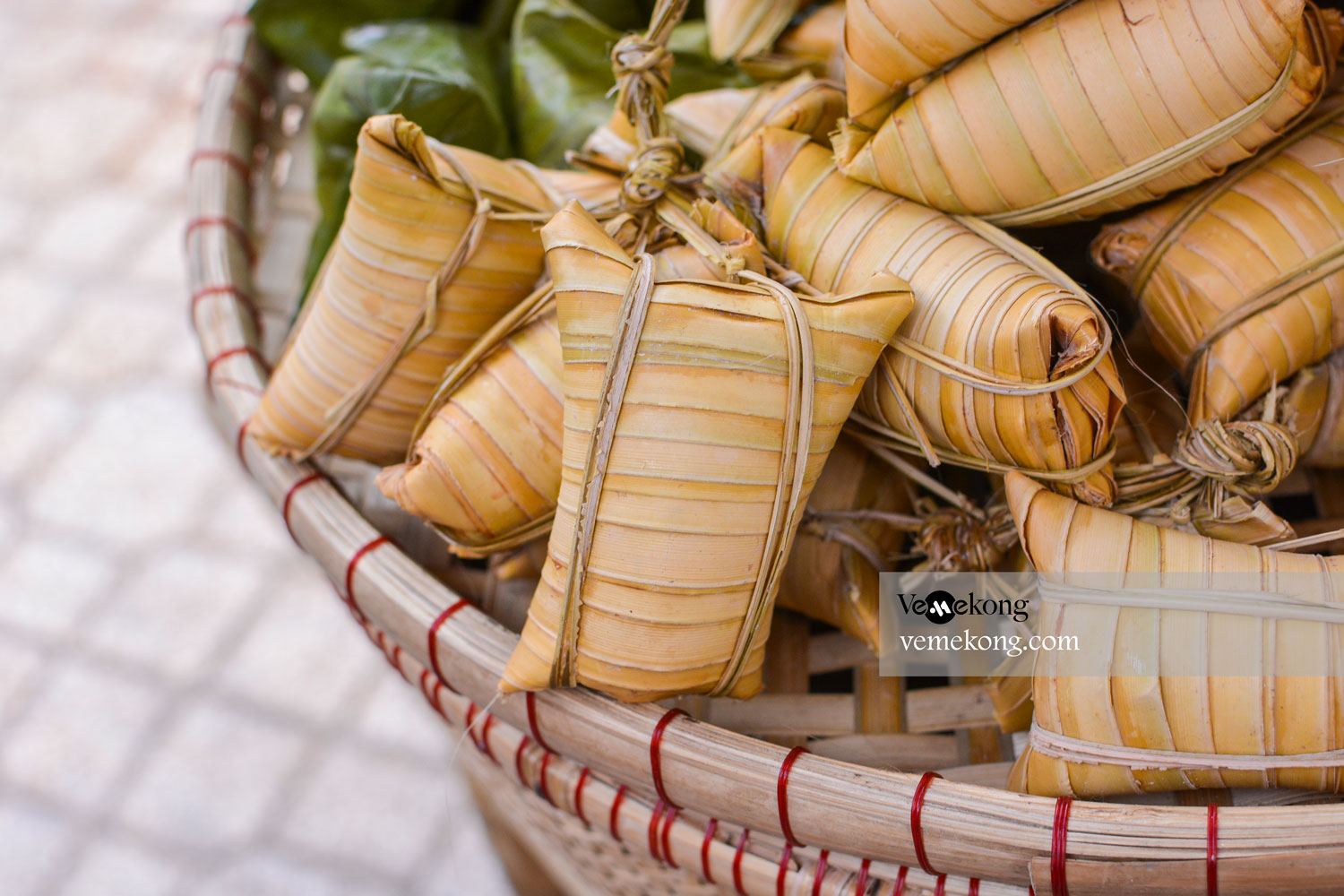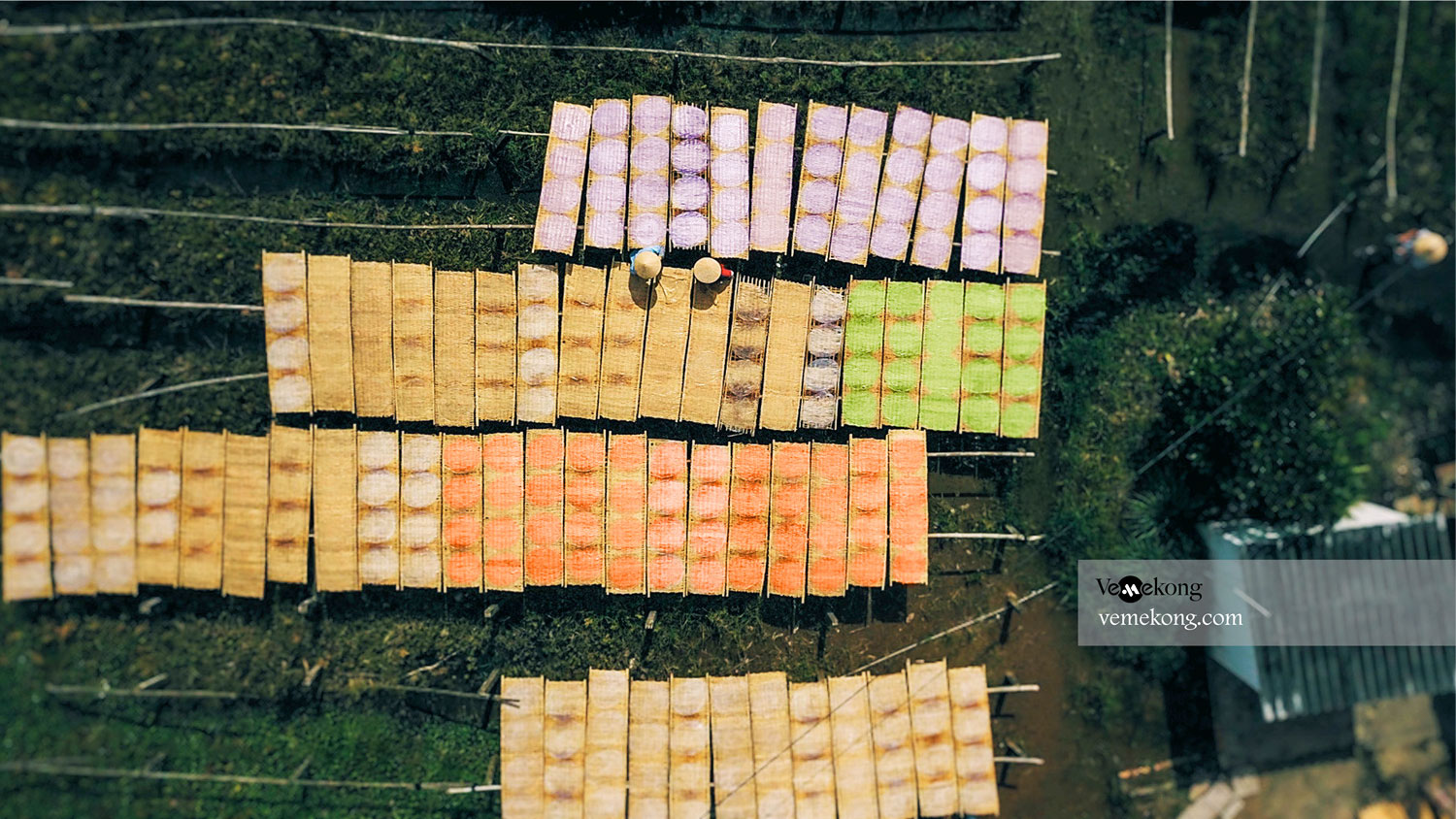Along with Tet Cake, It Cake, U Cake, and Mini Sticky Rice cake (coconut leaf cake) of the Westerners have become familiar with every meal. Not too fancy, but coconut leaf cake satisfies people by the wonderful blend of many ingredients. In particular, traveling to Can Tho, visitors will feel a unique taste of coconut leaf cake.
By Thomas Vietnam at vemekong.com | All Best Foods & Restaurants in Can Tho
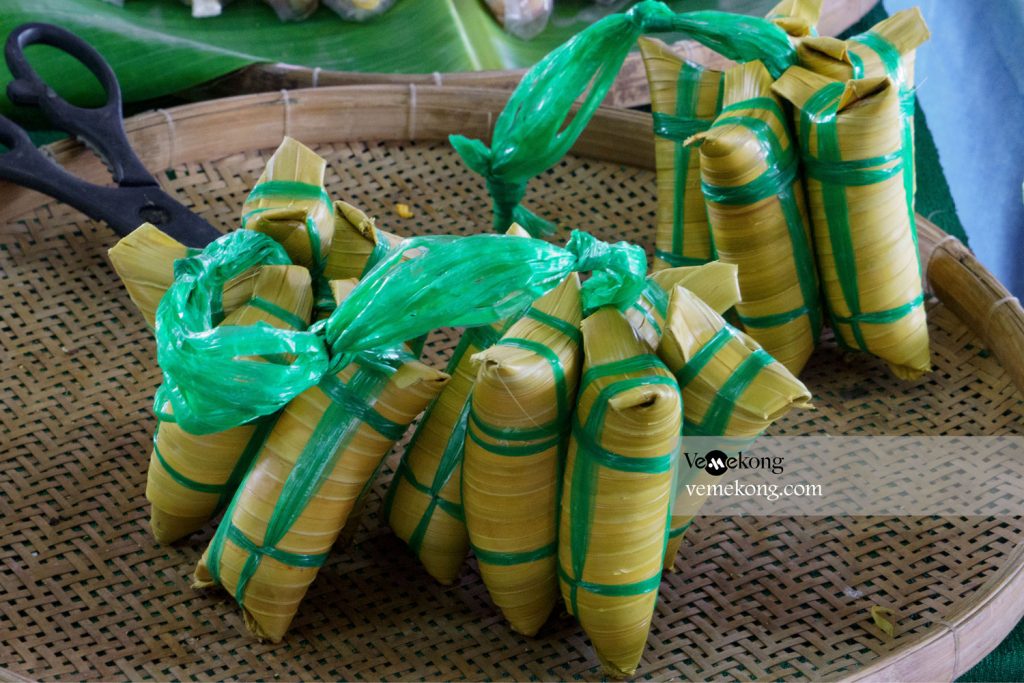
1. Better to Know as a Food Lover
Find them: Ninh Kieu District, Can Tho city.
Best time: Dusk-Dawn
Don’t miss: Mini sticky rice cake
Local’s pick: Ben Tre Coconut Leaf Cake Specialty Store in Can Tho
Tourist’s pick: Co 5 Coconut Leaf Cake restaurant, Nhu Y Coconut Leaf Cake restaurant…
Blog: https://vemekong.com/mini-sticky-rice-cake-can-tho-food/
Facts: It is called coconut leaf cake because their outer shape is created by young coconut leaves.
2. Better to Know Mini Sticky Rice cake
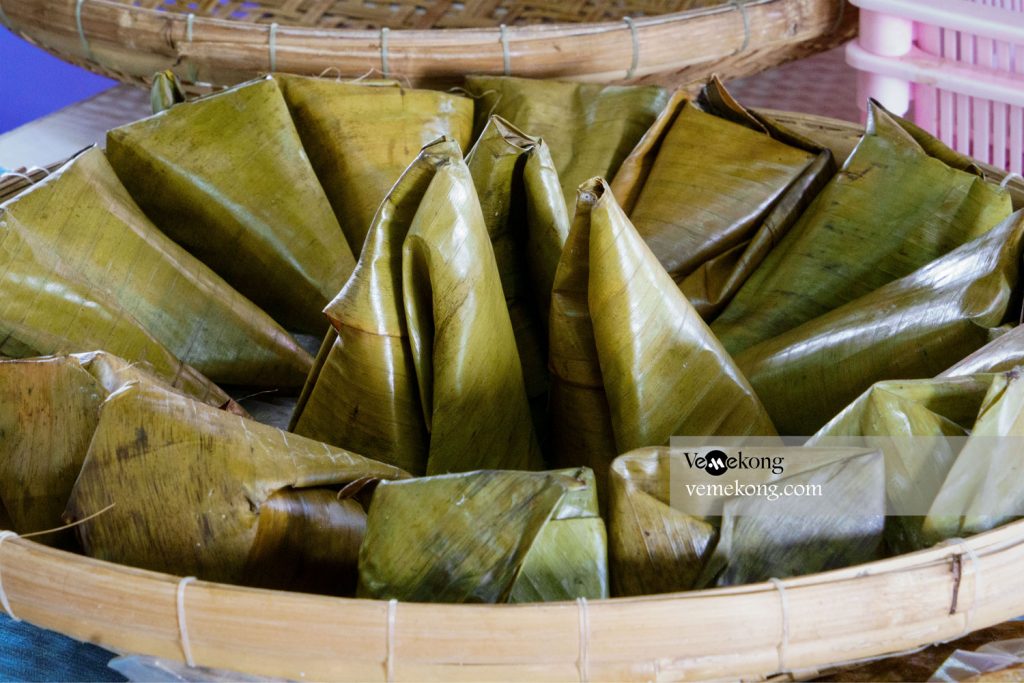
The first impression of this cake is the shape. Cakes are made from coconut leaves, spiral shaped like springs. Peel off the outer shell, you will begin to feel the distinct aroma of the cake.
In the West, coconut leaf cake is present in many provinces from Long An, Tien Giang, extending to Tra Vinh, Soc Trang, but Ben Tre is the capital of this cake with a crust made from coconut leaves.
Before wrapping, coconut leaves are trimmed into tubes, clean glutinous rice is mixed with black beans, fresh copra, and coconut milk. Just like that, go inside. Coconut leaf cake is usually wrapped with green bean paste like Chung Cake, Tet cake. In addition, to change the taste, Westerners also use porcelain bananas to make fillings. That is the unique feature of coconut leaf cake.
In addition to coconut leaves, dried coconut is an indispensable material. To make the coconut leaf cake fragrant and fatty, the dried coconut is grated and mixed into the glutinous rice seeds before wrapping. Coconut milk is also mixed to create a shiny shine for the cake after it’s cooked.
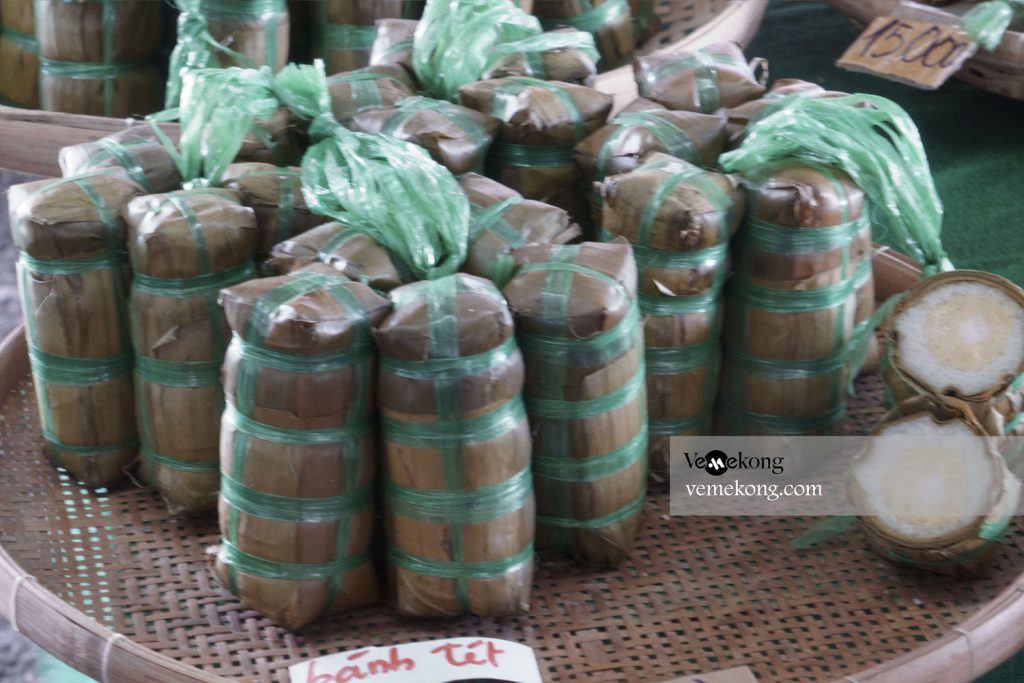
In order for the cake to be delicious, the baker needs to be skillful in putting sticky rice inside the coconut leaf roll. Hand-pressing wrinkles will cause the cake to become dry. The loose grip makes the cake easy to fall apart. In addition, if you want a delicious cake, you must choose the type of sticky rice that is really fragrant.
After that, you continue to use nylon rope or small wire from the leaf veins, which is the tool used to tie the cake after it has been wrapped. The packer usually bites one end of the rope, holds the rope tightly with his hand, and ties it tightly to fix the cake and the coconut leaf part from falling out.
Cakes before entering the oven are tied tightly into bunches. Each cake is almost a hand long, as big as a cucumber. The maker uses the color of the string to mark each type of cake. If it’s a banana filling, tie a green string, and if it’s a bean paste, tie a yellow string.
3. Mini sticky rice cake in Can Tho
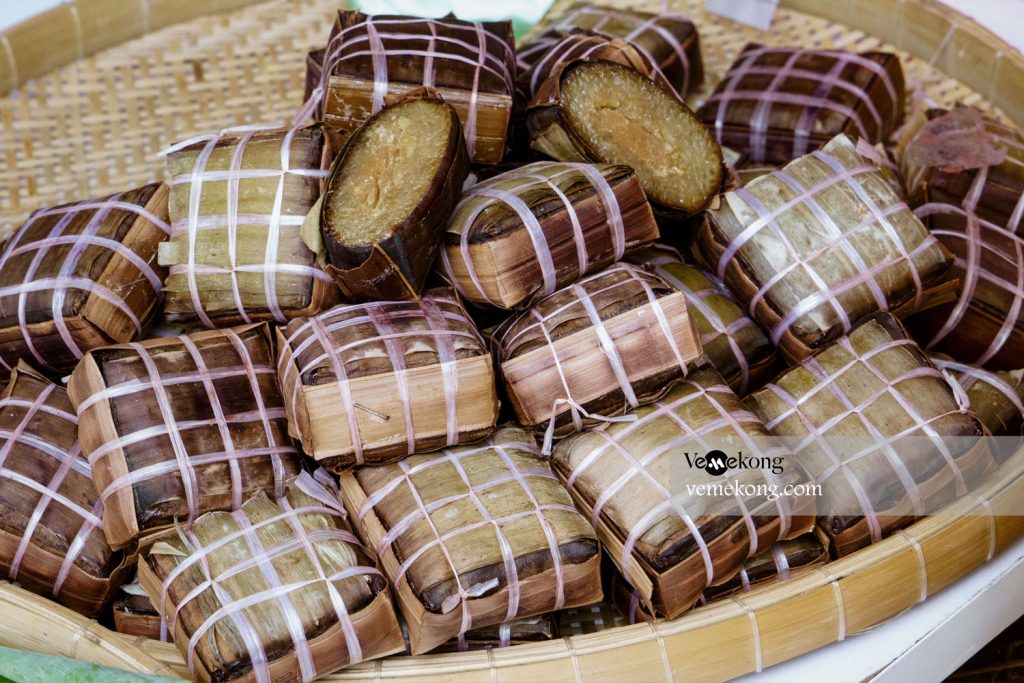
Cakes are cooked on a charcoal stove to create a cozy atmosphere
After wrapping the cake, it is put in a pot, cooked with a wood stove or coconut shell. Cooking takes more than an hour. Before opening the lid, just going through the cooking pot is enough to smell the aroma of coconut leaves, the kitchen and the smell of coconut milk to make people enjoy it.
After the cake is cooked, take it out and hang it to drain. Due to the tight and careful packaging, the shelf life of the cake is about 2-3 days without worrying about damage.
The average selling price for a cake ranges from 5 thousand VND to 15 thousand VND. It can be said that the coconut leaf cake in the West in general and in Ben Tre in particular has become a meaningful gift for locals and tourists. They are proud that the cakes made are both fragrant and delicious, and contain as much love and healing as the people here. If you have the opportunity to come to this land, don’t miss even a taste of coconut leaf cake.
4. How to Make mini sticky rice cake
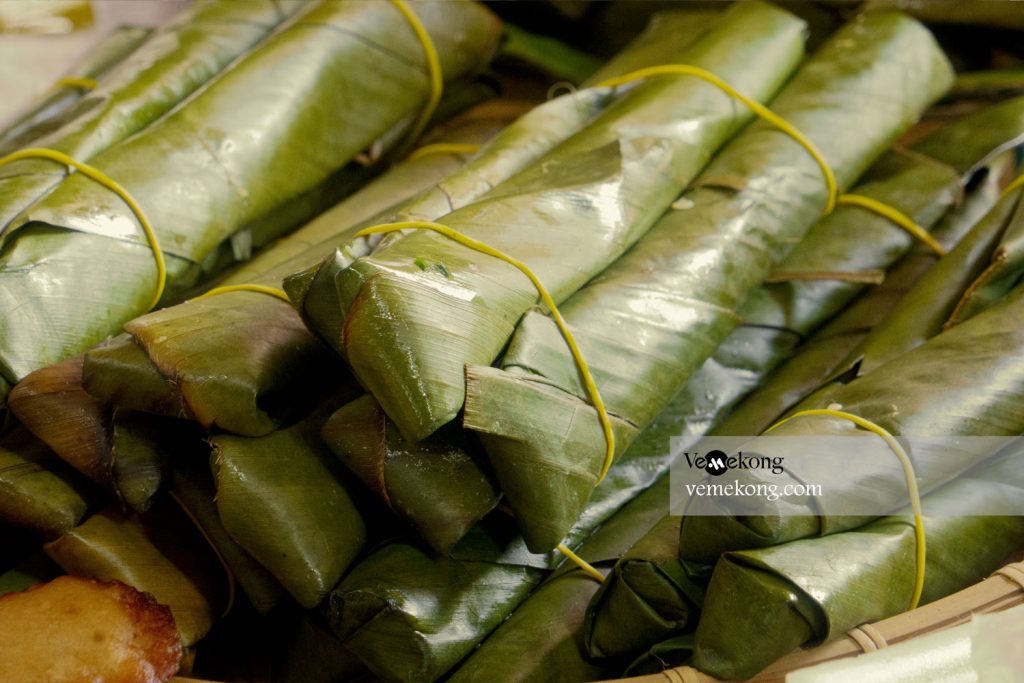
Ingredients for Coconut Cake for About 25 pcs
Glutinous rice 2 kg
White beans 150 gr
Siamese bananas 20 fruits
Sugar 100 gr
1 liter coconut milk
Salt 1 teaspoon
Coconut leaves 40 leaves
How to choose and buy fresh ingredients
How to choose and buy delicious sticky rice
Choose to buy glutinous rice grains of even size, opaque white, shiny outside and not broken.
Do not choose sticky rice with humus, hairy or yellow color.
In addition, delicious glutinous rice will have a natural aroma, similar to rice. As for the type of sticky rice that is kept for a long time, it will often lose its smell and when cooked, it will not keep its deliciousness.
You can taste the sticky rice with your mouth, if it has a mild sweetness and no strange smell, it is delicious.
You can refer to delicious types of sticky rice such as: yellow flower sticky rice, Tu Le sticky rice, Dien Bien upland sticky rice, goose sticky rice and velvet sticky rice.
How to choose to buy delicious white beans
Should choose beans with smooth skin, glossy color, in the middle of the bean, there are clear black spots that are not faint, the seeds are even, there is no roughness or tiny spots appear.
In addition, when pressed, the beans are still firm, not swollen inside or easily broken, the beans are new.
Besides, when you smell it, you will not hear any musty or strange odors.
How to choose to buy delicious fresh bananas
For this cake, you should buy black Siamese bananas to have a delicious taste.
Should choose bananas that are not ripe in color (with yellow and green fruits) and have dark pink or black spots.
Should not choose the ripe fruit, dark yellow skin.
Natural ripe bananas will have a yellow stem and body. The stem is green, but the ripe yellow fruit is definitely soaked in chemicals.
Ripe bananas will have a natural aroma and sweetness, soft evenly. Chemically-impregnated bananas, when eaten, will be slightly stiff, hard, acrid and sour.
How to make Coconut Leaf Cake
Step 1. Prepare the ingredients for the cake
First, you wash 2kg of sticky rice with water several times and then drain.
Next, soak 150g white beans with water for about 3-4 hours and wash them again.
Next, peel off the skin and fiber of the banana and put it in a large bowl, then marinate for 2 hours with 100g of sugar, 1 teaspoon of salt. When marinating the bananas, use a knife to cut the bananas in half.
Step 2. Roll coconut leaves to wrap cakes
Each cake will use about 2 coconut leaves, you cut off the veins, wipe the surface and then roll the leaves.
First, you break a piece of coconut leaf (about 5cm) up and then fix it with a toothpick. After that, you continue to roll the coconut leaf so that it hugs the piece of coconut that was fixed earlier.
Roll continuously until you run out of leaves, then you follow the 2nd coconut leaf and continue the circle. When the roll is close to the top of the leaf (pointed end), you use a toothpick to fix it and you’re done.
Step 3. Stir-fry sticky rice and mix beans
Put the pan on the stove, put in the drained glutinous rice, 1 liter of coconut milk, stir the mixture on low heat until the coconut milk seeps into the glutinous rice seeds, the sticky rice becomes soft, then turn off the heat.
When the sticky rice is done, add 150g of soft soaked white beans and mix well.
Step 4. Filling and wrapping cakes
First, put a little sticky rice inside the coconut leaf. Then, make a small hole and put the banana in the middle.
Next, spread it evenly on the face a few more folds and then use a string to tie the two ends.
Next, you use 4 strings to tie the cake, 2 strings to tie the cake across and the remaining 2 strings you stand up and then tie, remembering to tighten so that the filling inside is firmly compressed.
Do the same thing until you run out of ingredients.
Step 5. Boil the cake
Boil 1 pot of water, then you put the cake in and boil it over medium heat for 6 hours to be cooked. After the cake is done boiling, hang it up so that the cake can be drained and cool faster.
Step 6. Finished product
Coconut leaf cake has a soft sticky part, fatty leopard with coconut milk flavor and a little bit of flesh from white beans, the inside of the banana is sweet and sour, extremely delicious.
The cake is very suitable to use as a quick breakfast or as a snack in the late afternoon.
5. Pro tips:
Here are our tips for easing your mind (and stomach) around food-handling environments that you may not be used to.
Make sure the food is freshly cooked. If you’re eating hot street food, it’s always safest (not to mention more delicious) to eat food you can see being cooked to order.
Look for lines and busy stalls. Busy street food stalls are an indicator of popularity, and their high turnover rate means the food is never sitting out for hours and developing dreaded bacteria. Yes, long lines can be discouraging when you’re hungry after a full day of exploring, but it’s not worth the risk of grabbing precooked food from the empty spot next door.
Eat when the locals are eating. The last and most important element here is when to eat. You’re likely already on a weird eating schedule while you’re traveling, but it’s important to try and adjust to the eating times of where you are. A bowl of pho might be lunch for Americans, but it’s breakfast for the Vietnamese. This ensures that you’re eating freshly cooked food and that you can find the best and most popular places to eat.
If you can’t drink the water, then you can’t eat the salad. Most people get so hung up on not drinking the water or skipping ice in drinks that they don’t think about all of the other ways in which water is used in food service. Fruits and vegetables tend to be washed with tap water in most places, rather than the filtered water that locals drink—or sometimes it’s not washed at all. If you’re really craving some produce, try fruits you can peel or cooked veggies.
Trust your gut. If you’re unsure about the food or the way that it’s being prepared, then keep moving. Eating street food all over the world doesn’t make you an expert. Every stall and every country are different, and sometimes the rules can be harder to follow. When something doesn’t look, smell, or feel right, don’t eat it! Trust your judgment. Chances are that there’s another spot close by that’s making something more delicious.
Must-Eat Foods & Restaurants in Can Tho: Co Ut’s Cong cake, Ut Dzach Fine Rice Vermicelli, Thanh Van Grilled Pork Sausage, Crab Noodle Soup At Floating Market, Scorched Rice with Caramelized Fish Sauce, 7-Toi’s Duck Meat Pancake, Banh Mi Thuy, Banana Blossom Salad, Fried Spring Rolls, Fresh Spring Rolls, Fetal duck egg (balut), Honeycomb Cake, Mini Sticky Rice Cake, Cassava Silkworm Cake, Grilled Banana Wrapped in Sticky Rice, Khmer-style Bun Goi Da Soup, Egg Coffee, Con Son Grilled Snakehead Fish, Bun Mam – Fermented Fish Noodle Soup, Lau Mam – Fermented Fish Hotpot, Grilled Snails with Pepper, Magenta Sticky Rice Cake, Duck cooked with Fermented Tofu, Rice Noodle Pizza, Vegetarian Noodle Soup, Snails Stuffed With Pork…
Must-Eat Foods & Restaurants in Chau Doc: Chau Doc Fish Noodle Soup, Sugar Palm Fruit, Basa Fish Hot Pot, Mam (Fermented fish), Phu Huong Beef Noodle Soup, Broken Rice with Pork Chop, Long Xuyen Broken Rice, Nui Cam Pancake, O Thum’s Chicken Grilled with Lime Leaves, Stir-fried Shrimp with Sesbania Flower, Sweet & Sour Soup with Siamese Mud Carp Soup & Sesbania Flower, Caramelized & Braised Catfish, Grilled Rice-field Rat with Salt and Chili…
Must-Eat Foods & Restaurants in Soc Trang: Pia Cake, Cong Cake (Banh Cong), Bun Nuoc Leo Soc Trang’s Noodle Soup, Soc Trang’s Bun Goi Da Soup, Duck Noodle Soup with black Pepper, Curry Noodle Soup, Grilled Beef on Tile, Khmer-style Tube Cake, Khmer-style Mung Bean Cake (Banh In), Dried Radish (Xa Bau), Stir-Fried Noodles with Seafood (Mi Sua), Soc Trang’s Green Rice Flakes…
Must-Eat Foods & Restaurants in Ben Tre: Phu Le Rice Wine, Ben Tre’s Coconut Candy, Flat Banana, Coconut Rice, Snail Pancake, Sea Snail with Coconut Milk, Coconut Worm, Young Coconut Salad with Shrimp & Pork, Son Doc Puff Rice Paper…
Must-Eat Foods & Restaurants in Cai Be: Puffed Rice Cake…
Must-Eat Foods & Restaurants in Vinh Long: Elephant Ear Fish (fried giant gourami)…
Must-Eat Foods & Restaurants in My Tho: Fried Sticky Rice, Snakehead Fish Rice Porridge, Hu Tieu My Tho (Noodle Soup), Coconut Banana Cake…
Must-Eat Foods & Restaurants in Tra Vinh: Macapuno Coconut, Bun Nuoc Leo Tra Vinh’s Noodle Soup, Tra Cuon’s Sticky Rice Cake…
Must-Eat Foods & Restaurants in Sadec: Sa Dec Noodle Soup, Sadec Crab Hotpot, Lai Vung Spring Rolls, Sa Giang Shrimp Puff Pastry, Lai Vung Tangerine…
Must-Eat Foods & Restaurants in Bac Lieu: Spicy Beef Noodle Soup, Bac Lieu’s Three-striped Crab, White Radish Pies, Bac Lieu Thick Noodles & Creamy Coconut Milk, Bon Bon Pickles…
Must-Eat Foods & Restaurants in Ca Mau: Banh tam ga cay (Silkworm rice cake with curried chicken), Grilled Vop clams with salt and pepper, Grilled Mudskipper Fish, Stone Crab Roast With Salt, Young Bee Salad, Nam Can’s Crab, U Minh Forest’s Honey, U Minh’s Fermented Fish Hotpot…
Must-Eat Foods & Restaurants in Hau Giang: Cau Duc Pineapple, Cai Tac’s Pork Organs Porridge, Hau Giang’s Bronze Featherback Fish Cake…
Must-Eat Foods & Restaurants in Ha Tien: Herring Fish Salad, Spider crab cake soup, Ken Noodle soup, Xoi Xiem (Siamese sticky rice), Steamed Noodle soup, Ha Tien Oyster porridge…
Must-Eat Foods & Restaurants in Rach Gia: Stir Noodle Soup, Kien Giang Fish Noodle Soup…
Must-Eat Foods & Restaurants in Con Dao: Bang nut jam, Vu Nang Snail, Roasted Pork Bread (Banh Mi), Coconut Ice Cream…
Must-Eat Foods & Restaurants in Phu Quoc: Phu Quoc Sim Wine, Phu Quoc Pepper, Phu Quoc fish sauce…
Hopefully, the above tips will help you to come up with a great plan for your adventure in Mekong River Delta, Vietnam. Have a safe trip!
“Sleep less, travel more, respect more” – Thomas Vietnam – Local travel expert.
Thank you
